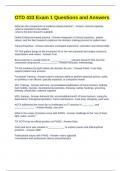OTD 433 Exam 1 Questions and Answers
What are the components of evidence based practice? - Answer--clinical expertise
-what is important to the patient
-what is the best research available
Define Evidenced based practice - Answer-integration of clinical expertise , patient
values, and the best research evidence into decision making process for patient care
Clinical Expertise - Answer-clinicians cumulated experience, education and clinical skills
T/F The patient brings to the encounter his or her own personal and unique concerns,
expectations and values - Answer-True
Best evidence is usually found in _______________ relevant research that has bee
conducted using sound ____________. - Answer-clinically; methodology
T/F the evidence by itself makes the decision for you. - Answer-False: it can help
support patient care process.
Functional Training - Answer-used to improve ability to perform physical actions, tasks,
or activities in an efficent, typically expected, or competent maner
ADL Training - Answer-self care, accomodation/modification of home barriers, bathing,
bed mobility, transfer, developmental activities, dressing, eating, feedings, grooming,
toileting ,wheelchair, external supports
IADL training - Answer-domestic life; accomodation/modif. of home barriers, caring for
dependents, driving/transportation, home maintenance, meal prep, shopping, yard work
AOTA addressed the issue dur to challenges to OT practice in _________ and
______________. - Answer-florida, new york
What is the scope of practice issue with PAMS - Answer-challenge to the "use of heat,
light, water, sound.."
T/F AOTA had an official position on PAMS - Answer-false
PAm task force was created in ____________ to explore issues and philosophical
positions - Answer-1990
Professional issues with PAMS - Answer--many opposed
-inconsistent with professions theory and philosophy
,______% physical disability practicioners felt PAMs was a natural evolution toward new
technologies - Answer-80%
_________% thought PAMS was consistent with the philosophical base - Answer-58%
Where do you go to find out about a state's modalities/thermal agent's specific law? -
Answer-Department of Health and Human Services
Outcome of PAMS - Answer-- inconsisitency between desire to clinicians to obtain
education and training at an academic level
-contributed to states adopting regulatory language to outline skills and training needed
_________ states with liscensing language or regulations specifiying training
requiement for PAMS application - Answer->26
FL, NY, IL, NE, SD, CA, MT, NH, NJ, GA, MD, KY, TN - Answer-states that identify
education/training requirements for PAMS and require seperate liscense.
Educational programs only need to ____________ but not _______________
application of PAMS. - Answer-demonstrate; perform
-lack of understanding of theoretical framework
-Top-down approach
-occupation as the end and means
-no reference to dx in the OT practice framework
-insecurity and inconsistency in whether OT's diagnose - Answer-Theoretical issues of
PAMS
What is the OTPF missing? - Answer-- we don't diagnose
-but we can have a clinical impression
Activity demand - Answer-components and characteristic of activity will determine
demand of activity and impact the skill or completion of performance
Activity demands are __________ to specific __________ _________. - Answer-linked;
client factors
Client factors - Answer-components which reside within or are unique biophysiological
factors of teh individual
Client factors __________ the ability to ___________ in occupations. - Answer-affects;
engage
Difference between OT and PT education - Answer--PT said to be medically based/
reductionistic
-We went from reductionistic to a hybrid of medical and community components
, -OT needs to be better at medical component
What kind of patient has a better outcome after a hip or knee replacement? - Answer-
patient who are physically active prior to srugery
At what point do you put in a shoulder arthroplasty? - Answer-- when they have
uncontrolled pain
- movement needs to be at 90 flexion and abduction
Significance of PAMS - Answer-- impact CF
-influence biophysiological fctn of tissue
-influence cardio, hematological, and immunological systems
-use preparatory to treating a variety of neuro-musculo, movement mrelated and
sensory functions
What caused a change in clinical reasoning for PAMS - Answer-- it impacts
performance at cellular level
-modifies cellular/histochemical activity within body
T/F you need to engage in actiity and occupation when using PAMS - Answer-true
Physical agent modalities - Answer-procedures and interventions that are systematically
applied to modify specific client factors when neurological, musculoskeletal, or skin
conditions arepresent that may be limiting occupational performance
Purpose of using the energy of PAMS - Answer-- modulate pain
-modify tissue healing
-increase tissue extensibility
-modify skin/scar tissue
-decrease edema/inflammation
T/F PAMS are used in preparation for or concurrently with purposeful and occupation
based activities - Answer-true
Types of energy - Answer-heat, cold, water, pressure, sound, electromagnetic, radiation
and electrical currents
Types of Kinetic Energy - Answer-thermal, mechanical, electrical, magnetic
Types of potential energy - Answer-chemical, elastic, ,nuclear, gravitational
Soft tissue is made out of ______________. - Answer-collagen
Why does your skin get wrinkly as it ages? - Answer-loss of collagen




